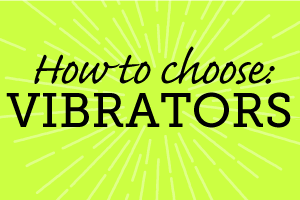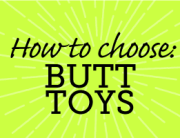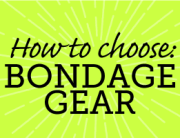We’ve made a conscious decision to include only quality products in our store. Nowhere is this decision more evident than in the vibrator category! You may have seen products that appear to be the same design for less money; we caution you to look closer. Some manufacturers producing sex toys have little or no concern about the performance of their product. Many use inferior switches and components manufactured in poor working conditions. The result is, not surprisingly, unreliability and short life expectancy. As consumers we demand quality in the things we buy. Why should sexual products be any different?
The right tool for the job is key when selecting a vibrator. Yes, they all vibrate, so does the washer in spin cycle! However, the washer is probably not the right tool for adding clitoral stimulation to sex play with your partner (though we’re always interested in creative endeavours).
Here are some good questions to ask:
Do I want something for clitoral (external only) stimulation, or penetrative stimulation, or both?
Why do we care whether the intended use is clitoral, penetrative, or a combination? Because women orgasm differently, depending on which nerve system is being stimulated and knowing what sort of stimulation you’re after helps us match you up with the right product design to accomplish the task. Exterior stimulation (clitoral, labia and perineum) triggers the pudendal nerve system, which responds to tactile contact. If you know that you want clitoral vibration, you’ll need more than just a vibrating shaft. Vibrators work by stimulating the bundle of nerve endings clustered in the clitoris. External contact is crucial so make sure that any penetrative option has a corresponding base or extension for labia and clitoral contact.
Internal (vaginal) stimulation triggers the pelvic nerve system, which responds to firm pressure. Hence, an inert vibrating object will provide little or no vaginal stimulation when merely inserted but may, when placed across the clitoris and labia, be quite stimulating. Conversely, a dildo of the appropriate length and circumference, stroking upwardly against and along the vaginal walls can be very stimulating without any vibration whatsoever. Vibration may also be pleasant on the G-spot and definitely gets the nerve endings in the rectum going.
What’s that Rabbit dual vibe thing all about?
Some vagina-owning people reach orgasm only while the clitoris is stimulated at the same time as penetration is occurring. This is known as a “combined” or “blended” orgasm. Dual vibes do this one thing particularly well. Their shafts rotate (or wave) to create stroking on the vaginal walls, while the external vibe flicks the clit. Both elements are separately controlled so you can customize the action to what works for you. The range of movement in the shaft is key. If you were to use these toys in a thrusting manner you couldn’t maintain constant contact with the clitoral vibrator. In some models, the full length of the shaft must be inserted to have clitoral contact.
For the right person, these toys are wondrous indeed, but we must warn you that they are not for everyone. For example, if you need a whole lot of pressure on that anterior wall of the vagina, if you’re a real “cowgirl”, you might find that these toys don’t have the guts. The rotating shaft’s mechanics operate under a lot of stress, when you consider the clenching of the vaginal muscles. They should not be “ridden”. If you clench down too hard on the shaft’s rotation it will either struggle to move, or stop entirely. For this reason, we highly recommend a silicone vibe with a replaceable motor or a combination of an external-use clitoral vibe and silicone dill or silicone plug for vibrating penetration. This option is best for versatility and long term cost effectiveness.
Do I want to use it in the tub or the shower?
If you enjoy sexy tub time, or your only alone time is when you bathe, (or like me everything you touch inexplicably flies out of your hands and ends up in the toilet), an aquatic vibe might be just the thing for you! Some vibes are waterproof (submersible) and some are water-resistant (shower friendly, but don’t immerse in the bath – or the toilet).
Do I require a lot of power?
If you require a lot of power, something that plugs in is always a good bet. The top-end rechargeable vibes have also started to offer a lot of power, giving the stalwart old plug-in models a run for their money. If intense vibration isn’t a requirement, vibes that run on batteries offer more mobility and a smaller physical size.
Do I have a toy that I love? Does it have a high, “zingy” frequency, or a low, “rumbly” frequency? (Is it a Kawasaki or a Harley?)
If you can identify the approximate frequency of the vibe you love, we can try to narrow your field of options. Also, if you take a picture of the vibe you loved, there’s a pretty good chance that we can identify it and find a similar one for you!
How about adding a vibrator power scale (like from 1 to 10) to your product descriptions?
That’d be easy to set up but near impossible to do! Vibe power scales are remarkably similar to the customer toy ratings (which we also don’t use) in that a rating is only accurate to the person doing the rating. Everyone’s personal nervous system perception of vibe strength varies with the individual! We’ve tried to overcome this “beauty is in the eye of the beholder” effect by making evaluative statements regarding vibrator power in situations where we feel most confident that the evaluation will hold across a broad spectrum of users. For example with silicone sheathed products we’ll note that because silicone is very conductive “the vibration is even throughout”, with vibrators that have a variety of settings, we say “you’ll get the maximum benefit from the various settings on the vibe … Low, Medium and High steady vibration …”, or we’ll point out the choice “for a woman who prefers directly focused intense vibration” and “lots of power”.
Is there a totally silent vibrator?
Ahhh … the sound issues. You’ll notice that we don’t *usually* describe the sound of our vibes. That’s because (actual decibel-counters aside) most of our customers have wildly differing opinions on what’s “too loud”. By way of explanation: one reason that it’s so hard to find a vibe that’s “silent”, is that vibration is sound and sound is vibration. The act of displacing air with vibration makes sound. We know, that sounds really obvious but it should be mentioned because it’s a decent reason why it’s difficult to make a soundless vibe. Then, when they start to age, their parts start to knock against each other or the tiny weights attached to the motor can come out of phase and then they really start to rumble!
One way to minimize noise is to shy away from vibes with hard plastic cases. The softer and thicker the casing, the less sound the “walls” make while the motor is whirling around inside. Another strategy is to go for embedded motors in place of the removable inserts (they tend to jiggle and buzz around in the cavity) Of course, there are always exceptions to every rule. When we do go out on a limb and talk about sound in our product description, sit up and listen because it means we are putting it out there that one model is quieter, relatively speaking, than another. Parting thought: Silence may be golden, but it is often also an indication of a less powerful vibe!






